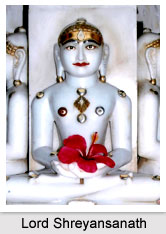 Lord Shreyansanath was the eleventh Jain Tirthankara of the current age, Avasarpini. As per Jain philosophy, he became a Siddha - an enlightened soul which has destructed all of its karma. Shreyansanath was born to Emperor Vishnu Raja and Queen Vishnu Devi Rani at Sinhpuri in the Ikshvaku dynasty. He was born on the twelfth day of the Falgun Krishna month of the Hindu calendar. In his earlier avatar Lord Shreyansnath purified his soul as Emperor Nalingulm, and went to the Mahashakra dimension of Gods.
Lord Shreyansanath was the eleventh Jain Tirthankara of the current age, Avasarpini. As per Jain philosophy, he became a Siddha - an enlightened soul which has destructed all of its karma. Shreyansanath was born to Emperor Vishnu Raja and Queen Vishnu Devi Rani at Sinhpuri in the Ikshvaku dynasty. He was born on the twelfth day of the Falgun Krishna month of the Hindu calendar. In his earlier avatar Lord Shreyansnath purified his soul as Emperor Nalingulm, and went to the Mahashakra dimension of Gods.
Resurrection of Lord Shreyansanath
Later from his first birth Lord Shreyansanath descended and was born as Shreyans Kumar to Emperor Vishnuraja and queen Vishnu Devi of Simhapur. Shreyans Kumar was born on the twelfth day of the dark half of the month of Bhadrapad.
Lord Shreyansanath led a normal princely life and later when his father, Emperor Vishnuraja retired he ascended the throne. After a long reign Shreyans Kumar became a Shraman. Within a short span of two months of religious practise he attained nirvana on the fifteenth day of the dark half of the month of Magh under a mango tree. He achieved nirvana at Sammetshikhar on the third day of the dark half of the month of Shravan.
It was during his period that the being that was to be Bhagwan Mahavir reigned as the first Vasudev Triprishta. After the death of Triprishtha, his brother Baldev Achal became a follower of Dharmghosh who was a devotee of Shreyansnath. He got enlightened and attained nirvana in this birth.
This article is a stub. You can enrich by adding more information to it. Send your Write Up to content@indianetzone.com









